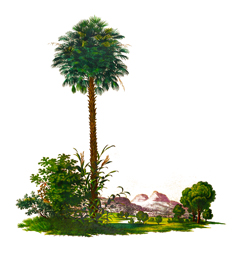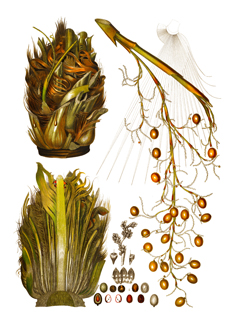 |
|
https://edibleplants.org/ |
 |
| https://edibleplants.org/ |
Translate this page:
Summary
Copernicia prunifera or Carnauba Palm is a tropical fan palm native to north eastern Brazil. It grows up to 20 m in height with trunk diameter of up to 25 cm. It has a circular tree crown. The flowers are bisexual. The fruits are round, small, and black. The plant, particularly the coating of the leaves, is a source of carnauba wax which is used to make varnishes, lubricant, soap, candles, etc. The fruit and pith are edible. The pith has high starch content and is used to make sago. The trunk also yields an edible gum. The leaves and the apical bud are both eaten as vegetable. The seed is used as coffee substitute and is a source of oil. The leaves are used as thatching and weaving material. Leaf fibres are made into ropes. The wood is used for fuel, poles, fencing, etc. The plant is drought resistant. Other names include wax palm and carnauba.
Physical Characteristics

 Copernicia prunifera is an evergreen Tree growing to 12 m (39ft) by 3 m (9ft) at a slow rate.
Copernicia prunifera is an evergreen Tree growing to 12 m (39ft) by 3 m (9ft) at a slow rate.
See above for USDA hardiness. It is hardy to UK zone 10.
Suitable for: light (sandy), medium (loamy) and heavy (clay) soils and prefers well-drained soil. Suitable pH: mildly acid, neutral and basic (mildly alkaline) soils. It cannot grow in the shade. It prefers moist soil and can tolerate drought.
UK Hardiness Map
US Hardiness Map
Synonyms
Arrudaria cerifera (Arruda) Macedo Copernicia cerifera (Arruda) Mart. Corypha cerifera Arruda Palma
Plant Habitats
Edible Uses
Edible Parts: Oil
Edible Uses: Coffee Gum Oil
The pith of the trunk is rich in starch and is used to make sago[ 301 ]. An edible gum is obtained from the trunk[ 301 ]. Young inflorescences[ 301 ]. The seed is used as a coffee substitute[ 301 ]. Leaves - cooked[ 763 ]. The apical bud, often known as a 'palm heart', is eaten as a vegetable[ 763 ]. Eating this bud leads to the death of the tree because it is unable to make side shoots[ K ].
References More on Edible Uses
Medicinal Uses
Plants For A Future can not take any responsibility for any adverse effects from the use of plants. Always seek advice from a professional before using a plant medicinally.
Antiarthritic Antirheumatic Depurative Diuretic Skin
The roots are depurative and diuretic. A decoction is considered a specific treatment for syphilis, and is also used in the treatment of arthritis, rheumatism, dermal afflictions and oedema[739]. A wax obtained from the leaves is used in the preparation of ointments and cataplasms[739].
References More on Medicinal Uses
The Bookshop: Edible Plant Books
Our Latest books on Perennial Plants For Food Forests and Permaculture Gardens in paperback or digital formats.

Edible Tropical Plants
Food Forest Plants for Hotter Conditions: 250+ Plants For Tropical Food Forests & Permaculture Gardens.
More

Edible Temperate Plants
Plants for Your Food Forest: 500 Plants for Temperate Food Forests & Permaculture Gardens.
More

More Books
PFAF have eight books available in paperback and digital formats. Browse the shop for more information.
Shop Now
Other Uses
Basketry Fencing Fibre Fuel Gum Oil Polish Soap making String Thatching Varnish Wax Wood
Other Uses: A high quality wax is obtained from the lower surfaces of the leaves[ 297 , 768 ]. It is very hard and has a high melting point[ 46 ]. It is used to make various high quality polishes and varnishes, phonographic records, lubricants, soaps, candles etc[ 46 , 297 , 419 ]. The leaves can be used for thatching and weaving into articles such as mats, baskets and hats[ 297 , 454 ]. The leaves (probably the fibre from them[ K ]) are used to make ropes[ 419 ]. An oil is obtained from the seeds[ 419 ]. The wood is soft, moderately heavy, long-lasting in salty water, easy to work. It is used for fencing, rustic buildings, laths, lathe work such as walking sticks etc[ 297 , 419 ]. The whole stems are used for poles[ 419 ]. The wood is used for fuel[ 419 ]. Landscape Uses: Attractive flowers.
Special Uses
Carbon Farming Food Forest
References More on Other Uses
Cultivation details
Industrial Crop: Wax Management: Standard Regional Crop
Plants succeed in moist tropical climates where temperatures never fall below 10°c, the average annual rainfall is 1,500mm or more and the driest month has 25mm or more rain[ 297 ]. They can also succeed in drier areas with an annual rainfall as low as 250mm and one month or more where rainfall is below 25mm[ 297 ]. Plants grow well in full sun, even when small[ 297 ]. Prefers a moist, well-drained soil[ 314 ]. Succeeds in saline soils[ 419 ]. A slow-growing plant[ 419 ]. It is grown commercially for the production of wax.
Carbon Farming
-
Industrial Crop: Wax
Water resistant, malleable substances. Currently, most commercial wax is made from paraffin - a fossil fuel.
-
Management: Standard
Plants grow to their standard height. Harvest fruit, seeds, or other products. Non-Destructive management systems.
-
Regional Crop
These crops have been domesticated and cultivated regionally but have not been adopted elsewhere and are typically not traded globally, Examples in this broad category include perennial cottons and many nuts and staple fruits.
References Carbon Farming Information and Carbon Sequestration Information
Temperature Converter
Type a value in the Celsius field to convert the value to Fahrenheit:
Fahrenheit:
The PFAF Bookshop
Plants For A Future have a number of books available in paperback and digital form. Book titles include Edible Plants, Edible Perennials, Edible Trees,Edible Shrubs, Woodland Gardening, and Temperate Food Forest Plants. Our new book is Food Forest Plants For Hotter Conditions (Tropical and Sub-Tropical).
Shop Now
Plant Propagation
Seed - there is no need to separate the seeds from the fruit before sowing. If stored seed is used then pre-soak for 24 hours in warm water. Sow the seed in a lightly shaded position in a nursery seedbed or in individual containers[ 419 ]. The seed can take 2 - 3 months to germinate[ 297 ]. Sprouting is slow, with a low germination rate[ 419 ]. Young seedlings grow slowly[ 419 ].
Other Names
If available other names are mentioned here
Copernicia prunifera or Carnauba Palm. Also known as: Carnauba, Carnauba wax palm, Wax Palm.
Native Range
SOUTHERN AMERICA: Brazil (Alagoas, Bahia, Ceará, Maranhão, Paraíba, Pernambuco, Piauí, Rio Grande do Norte, Sergipe, Tocantins)
Weed Potential
Right plant wrong place. We are currently updating this section.
Please note that a plant may be invasive in one area but may not in your area so it's worth checking.
None Known
Conservation Status
IUCN Red List of Threatened Plants Status : This taxon has not yet been assessed

Growth: S = slow M = medium F = fast. Soil: L = light (sandy) M = medium H = heavy (clay). pH: A = acid N = neutral B = basic (alkaline). Shade: F = full shade S = semi-shade N = no shade. Moisture: D = dry M = Moist We = wet Wa = water.
Now available:
Food Forest Plants for Mediterranean Conditions
350+ Perennial Plants For Mediterranean and Drier Food Forests and Permaculture Gardens.
[Paperback and eBook]
This is the third in Plants For A Future's series of plant guides for food forests tailored to
specific climate zones. Following volumes on temperate and tropical ecosystems, this book focuses
on species suited to Mediterranean conditions—regions with hot, dry summers and cool, wet winters,
often facing the added challenge of climate change.
Read More
Expert comment
Author
(Mill.) H.E.Moore
Botanical References
Links / References
For a list of references used on this page please go here
A special thanks to Ken Fern for some of the information used on this page.
Readers comment
| Add a comment |
|
If you have important information about this plant that may help other users please add a comment or link below. Only comments or links that are felt to be directly relevant to a plant will be included. If you think a comment/link or information contained on this page is inaccurate or misleading we would welcome your feedback at [email protected]. If you have questions about a plant please use the Forum on this website as we do not have the resources to answer questions ourselves.
* Please note: the comments by website users are not necessarily those held by PFAF and may give misleading or inaccurate information.
To leave a comment please Register or login here All comments need to be approved so will not appear immediately.
|
Subject : Copernicia prunifera
|
|
|
|